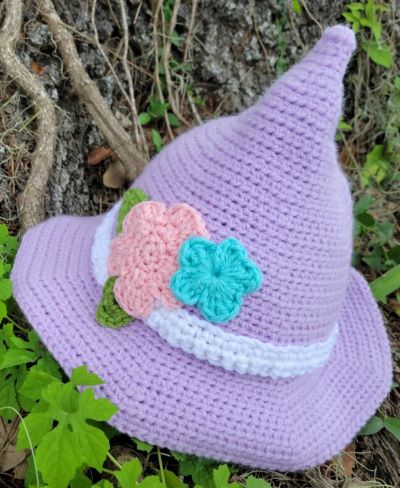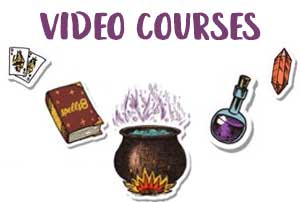Over the course of history, many objects and ideas have been associated with witches for one reason or another. These range from the bizarre, such as a witch not being able to swim, to the mundane, such as wearing a specific type of hat. Each of these ideas associated with witches and witchcraft has a history behind it. Some of that history is disputed, but others have a commonly accepted background.
In today’s post, we are going to discuss five signs of a witch, the history behind those signs, and how those signs may be viewed in the modern world.
The Cauldron
Every witch needs a cauldron, right? Did you know that cauldrons have long been associated with paganism, witchcraft, and spirituality? From Cerridwen’s cauldron to the Cauldrons of Poesy, this magickal symbol followed pagans and witches throughout history. In witchcraft, the cauldron is a vessel for rebirth and transformation. It is a tool used for potions, incense, and so much more.

In Welsh Mythology, Cerridwen’s cauldron was used to brew a potion for her son Morvran. According to mythology, Morvran was born very ugly, and Cerridwen was afraid he would not be accepted into the world of man due to his looks. She set forth to boil a potion for a year and a day to give her son the gift of intelligence and inspiration. She put Gwion Bach in charge of boiling the cauldron, and a blind many named Morda to kindle the fire beneath the cauldron. They were to never stop for fear the potion would stop boiling. However, everything went wrong when three drops of the potion fell on Gwion’s hand and, since it was hot, he put his hand in his mouth.
And one day, towards the end of the year, as Caridwen was culling plants and making incantations, it chanced that three drops of the charmed liquor flew out of the cauldron and fell upon the finger of Gwion Bach. And by reason of their great heat he put his finger to his mouth, and the instant he put those marvel-working drops into his mouth, he foresaw everything that was to come, and perceived that his chief care must be to guard against the wiles of Caridwen, for vast was her skill.
The Book of Taliesin https://www.sacred-texts.com/neu/celt/mab/mab32.htm
Historically, a cauldron may have been used for scrying, burning herbs, and creating potions. It was not only a tool used by witches, though! In almost every house, a cauldron could be found. This was one of the easiest ways to cool large pots of food, so it may have doubled as a normal household tool. This means that it was easy for anyone to get their hands on a cauldron.

A cauldron is not always a large, cast iron pot, either. The oldest cauldron ever found is the Gundestrup cauldron. This is a silver cauldron thought be date from between 200 BCE and 300 CE. It was found in 1891 in a peat bog in Denmark. What is interesting about this cauldron is the imagery on the outside. It contains images of animals such as cats, dogs, and potentially bulls. Each of these animals seems to be facing an antlered male figure sitting cross-legged, holding a torc in one hand and a serpent in the other. Many believe that this antlered figure is Cernunnos!
Today, the cauldron is still a tool used by witches around the world. We burn incense in our cauldrons, cast spells, and scry with the moon. As a vessel of transformation, rebirth, and creativity, a cauldron is a tool highly recommended for every witch!
The Witch’s Hat

Another common symbol of a witch is the witch’s hat! This one, though, has a disputed and potentially horrible history. There are several theories about the origin of the conical witch’s hat. They include antisemitism and an alewife’s hat. We may never know the origins of the witch’s hat, the pointy and wide headpiece that many witches still wear in pop culture. However, what we do know is that, throughout history, the idea of this hat being associated with witchcraft has stuck around!
The first theory behind the witch’s hat involves a pointed cap known as a Judenhat. This headpiece was one that Jewish people wore, originally by choice. However, after the Fourth Council of the Lateran in 1215, adult male Jews were required to wear the Judenhat to identify themselves while outside a ghetto. Some say that this hat then became associated with witchcraft, Satanism, and other things that the Jewish people were accused of.
Another theory is that of the alewife. An alewife was a woman who brewed beer at home for the purpose of selling it. These women often had extensive knowledge of herbs and brewing remedies, not just beer. The hats these women wore may have gained a negative connotation when the brewing industry, a male-dominated field, accused alewives of watering down their beer or selling tainted beer. This, combined with the general thought that women with knowledge of herbology were working in the occult, may have given the alewives’ hats an association with witchcraft!

Today, the witches hat is not usually worn outside of Halloween or for fun. Many people wear them because they are cute, or to remind themselves of their power as a witch. They can come in many shapes, sizes, and colors. Some are even decorated with flowers and other fancy images!
The Toad and Other Animals
One thing a witch is known for is their connection to animals. From toads to monkeys, every witch in pop culture is seen with what is known as a familiar. Some examples include the Wicked Witch of the West, who had flying monkeys, and the Halliwell sisters in Charmed, who had a cat named Kit. But what do these animals have to do with witches? Well, it is said that every witch has a familiar!
A familiar is usually thought to be an animal spirit companion. Depending on who you ask, this animal spirit is either a gift from the Devil, a demon itself, or a spirit summoned by the witch. The story of the witch’s familiar goes back hundreds of years, often being seen as a malevolent spirit meant to protect a witch as they came into their power.

In colonial America, we can see the idea of a witch’s familiar all throughout the Salem Witch Trials in 1692. The familiar spirits were often mentioned in the visions of the “afflicted” girls, and this was used to convict many people of witchcraft. For example, it is said that Sarah Good had a yellow bird who sucked between her fingers, and Tituba saw strange animals that urged her to hurt children.
In today’s age, a witch’s familiar is seen as a more benevolent spirit, usually manifesting as an animal. They have been known to protect witches from energetic and magickal attacks, find answers to their questions, and aid a witch in their spellwork. Historically, a witch’s familiar was a spirit that could manifest in physical form at will. In the modern age, there are many different opinions on familiars and how they present themselves.
No matter your thought on familiars, it is hard to deny that animals and spirits have played a large role in the history of witchcraft!
The Witch’s Mark
If you have freckles, moles, or other skin discolorations, watch out! You might have been suspected of witchcraft long ago! The witch’s mark, also called a devil’s mark, was a mark on the body that people believed to be a sign of witchcraft. This mark was believed to be a physical mark of the Devil upon a person, showing their initiation into his service and marking them to ensure obedience. These marks were often used in witch trials around the world to convict suspected witches of witchcraft. By the 1700s, this practice seems to have all but disappeared.

The witch’s mark does not play a role in modern witchcraft. However, that does not stop the trends from making their rounds! Recently, and mostly on TikTok, videos have surfaced of people finding their witch mark. Many of these videos will say that a freckle or mole in a certain place on your arm or hand means you are a witch! The validity of this is unfounded because anyone can be a witch. You do not need to have a freckly two inches above your index finger to practice witchcraft.
The Witch’s Broom
Lastly, we have the witch’s broom, otherwise known as a besom. Many people believe the broom became associated with witchcraft due to sympathetic magickal practices and pagan fertility rituals in history. The most common story is that of farmers and country folk gathering together, mounting their brooms, and running through the fields. They would jump as high as they could to encourage the crops to grow just as tall.

Others believe that the broom became associated with witches during the witch trials. This is where the story comes from of witches flying on brooms, a story associated with flying ointments and the Witch’s Sabbath. In 1324, Lady Alice Kyteler was tried for sorcery, and investigators reported finding a type of ointment that she would put on a staff which she “ambled and galloped through thicke and thin.” In another story, the theologian Jordanes de Bergamo wrote in his book Murder, Magic, and Medicine that “the vulgar believe, and the witches confess, that on certain days or nights they anoint a staff and ride on it to the appointed place or anoint themselves under the arms and in other hairy places.”
While most modern witches are not going to be found riding on brooms, for any reason, the broom is still a vital tool for the witch. Today, it is mainly used for sweeping away negativity and cleansing a space. These brooms, also known as besoms, come in many different shapes and sizes. They are easy to make and tailor to a witch’s specific intention!
Are you a witch?
So, do you have any of these tools or symbols? What is your favorite story, and how do you feel about these symbols being associated with witches and witchcraft? Let us know in the comments below!







I am covered in moles!!